Feminism Essay: Key Concepts of Feminist Theory and Analysis
VerifiedAdded on 2023/03/17
|6
|1456
|89
Essay
AI Summary
This essay examines several key concepts within feminist theory. It begins by defining emotional labour and its significance in both online and offline spaces, highlighting how women navigate emotional demands in various settings. The essay then explores intersectionality, discussing Kimberle Crenshaw's contribution and the importance of considering multiple factors beyond gender in feminist activism. Furthermore, it delves into Irigaray's concept of sexual difference, analyzing her critique of Western culture's bias and its implications. Simone de Beauvoir's famous statement about women is also explored, and the essay provides different interpretations of her ideas. Finally, the essay discusses Donna Haraway's cyborg manifesto, explaining how the cyborg figure represents the experiences and values of contemporary women. The essay draws on various sources to support its arguments and provides a comprehensive overview of these core feminist concepts.
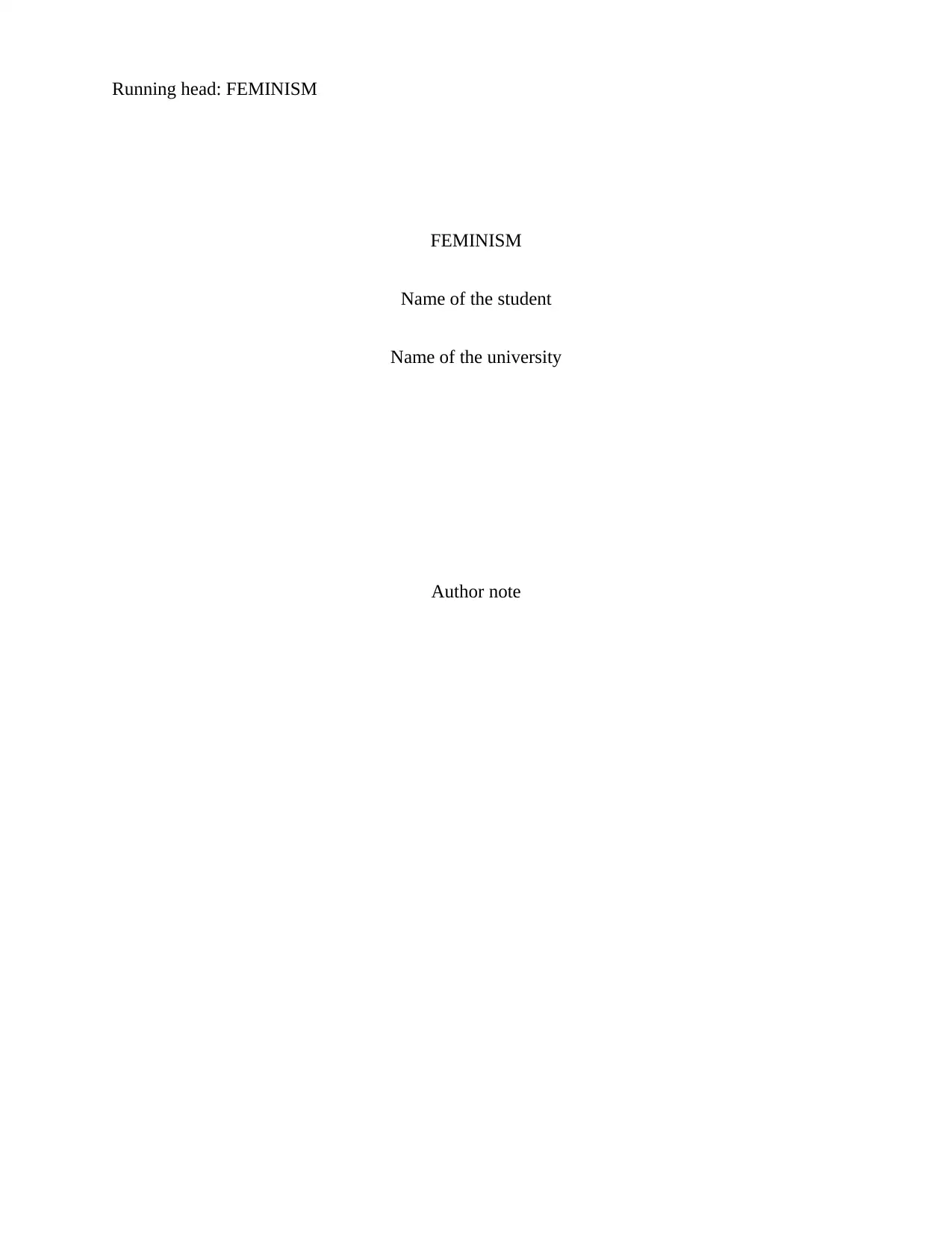
Running head: FEMINISM
FEMINISM
Name of the student
Name of the university
Author note
FEMINISM
Name of the student
Name of the university
Author note
Paraphrase This Document
Need a fresh take? Get an instant paraphrase of this document with our AI Paraphraser
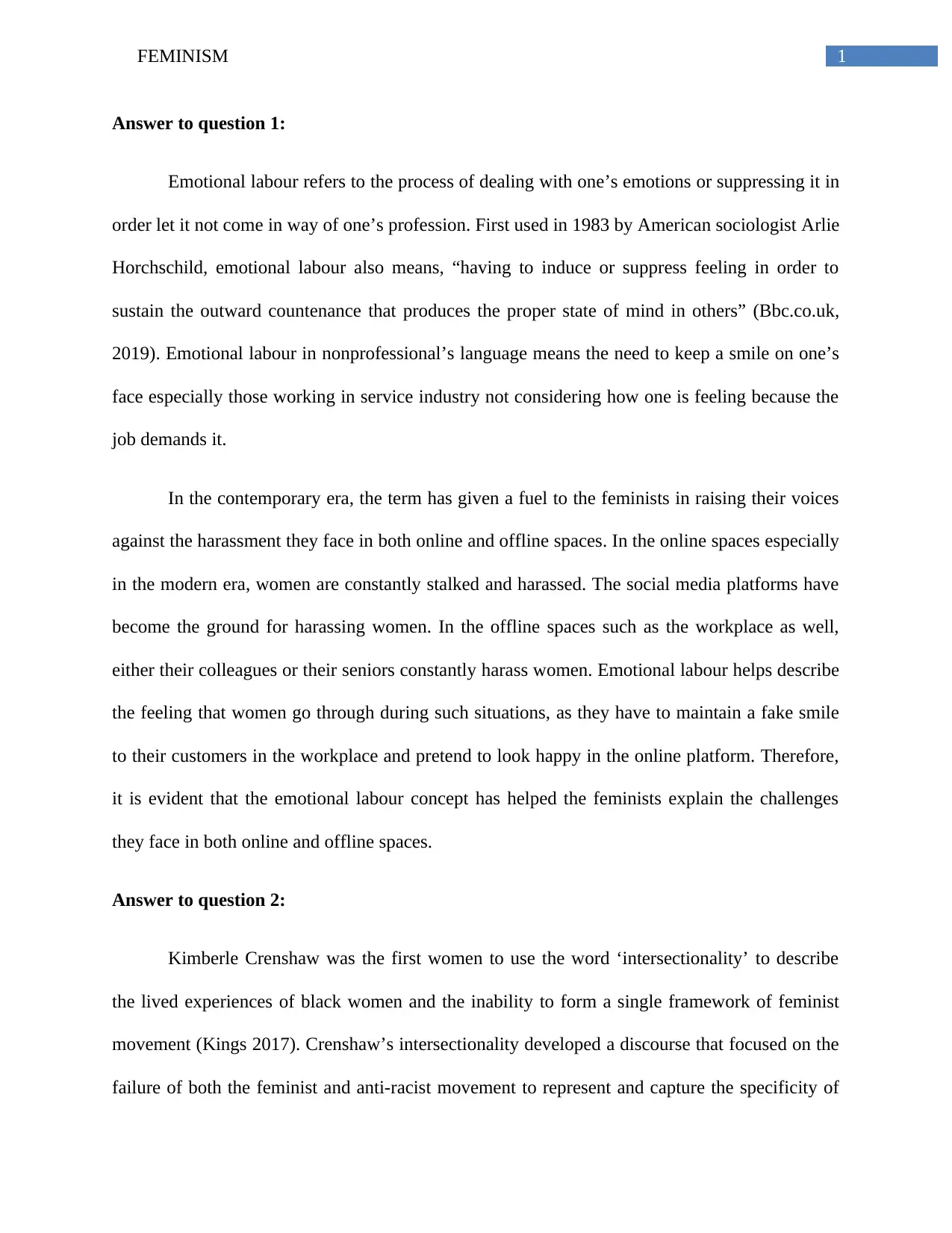
1FEMINISM
Answer to question 1:
Emotional labour refers to the process of dealing with one’s emotions or suppressing it in
order let it not come in way of one’s profession. First used in 1983 by American sociologist Arlie
Horchschild, emotional labour also means, “having to induce or suppress feeling in order to
sustain the outward countenance that produces the proper state of mind in others” (Bbc.co.uk,
2019). Emotional labour in nonprofessional’s language means the need to keep a smile on one’s
face especially those working in service industry not considering how one is feeling because the
job demands it.
In the contemporary era, the term has given a fuel to the feminists in raising their voices
against the harassment they face in both online and offline spaces. In the online spaces especially
in the modern era, women are constantly stalked and harassed. The social media platforms have
become the ground for harassing women. In the offline spaces such as the workplace as well,
either their colleagues or their seniors constantly harass women. Emotional labour helps describe
the feeling that women go through during such situations, as they have to maintain a fake smile
to their customers in the workplace and pretend to look happy in the online platform. Therefore,
it is evident that the emotional labour concept has helped the feminists explain the challenges
they face in both online and offline spaces.
Answer to question 2:
Kimberle Crenshaw was the first women to use the word ‘intersectionality’ to describe
the lived experiences of black women and the inability to form a single framework of feminist
movement (Kings 2017). Crenshaw’s intersectionality developed a discourse that focused on the
failure of both the feminist and anti-racist movement to represent and capture the specificity of
Answer to question 1:
Emotional labour refers to the process of dealing with one’s emotions or suppressing it in
order let it not come in way of one’s profession. First used in 1983 by American sociologist Arlie
Horchschild, emotional labour also means, “having to induce or suppress feeling in order to
sustain the outward countenance that produces the proper state of mind in others” (Bbc.co.uk,
2019). Emotional labour in nonprofessional’s language means the need to keep a smile on one’s
face especially those working in service industry not considering how one is feeling because the
job demands it.
In the contemporary era, the term has given a fuel to the feminists in raising their voices
against the harassment they face in both online and offline spaces. In the online spaces especially
in the modern era, women are constantly stalked and harassed. The social media platforms have
become the ground for harassing women. In the offline spaces such as the workplace as well,
either their colleagues or their seniors constantly harass women. Emotional labour helps describe
the feeling that women go through during such situations, as they have to maintain a fake smile
to their customers in the workplace and pretend to look happy in the online platform. Therefore,
it is evident that the emotional labour concept has helped the feminists explain the challenges
they face in both online and offline spaces.
Answer to question 2:
Kimberle Crenshaw was the first women to use the word ‘intersectionality’ to describe
the lived experiences of black women and the inability to form a single framework of feminist
movement (Kings 2017). Crenshaw’s intersectionality developed a discourse that focused on the
failure of both the feminist and anti-racist movement to represent and capture the specificity of
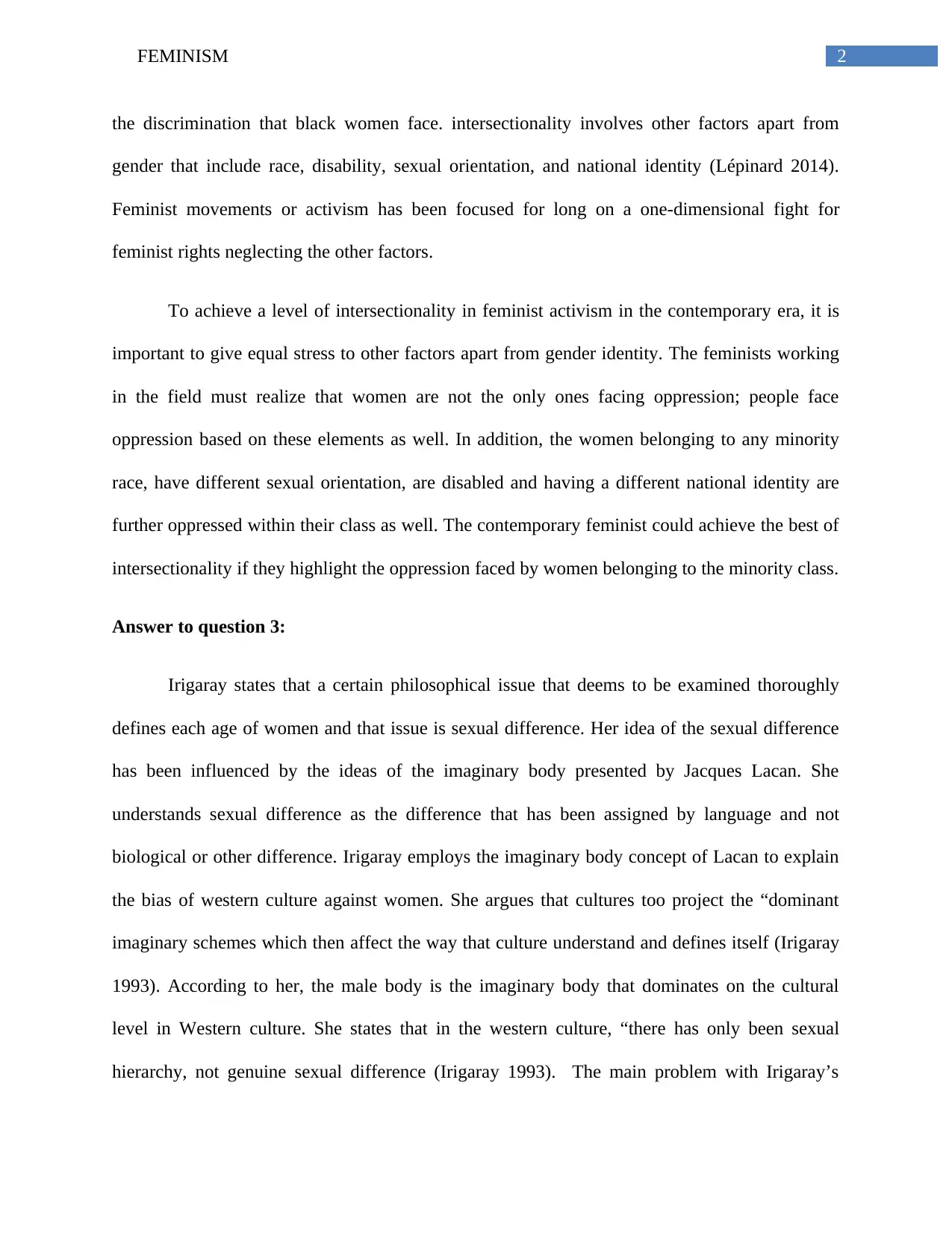
2FEMINISM
the discrimination that black women face. intersectionality involves other factors apart from
gender that include race, disability, sexual orientation, and national identity (Lépinard 2014).
Feminist movements or activism has been focused for long on a one-dimensional fight for
feminist rights neglecting the other factors.
To achieve a level of intersectionality in feminist activism in the contemporary era, it is
important to give equal stress to other factors apart from gender identity. The feminists working
in the field must realize that women are not the only ones facing oppression; people face
oppression based on these elements as well. In addition, the women belonging to any minority
race, have different sexual orientation, are disabled and having a different national identity are
further oppressed within their class as well. The contemporary feminist could achieve the best of
intersectionality if they highlight the oppression faced by women belonging to the minority class.
Answer to question 3:
Irigaray states that a certain philosophical issue that deems to be examined thoroughly
defines each age of women and that issue is sexual difference. Her idea of the sexual difference
has been influenced by the ideas of the imaginary body presented by Jacques Lacan. She
understands sexual difference as the difference that has been assigned by language and not
biological or other difference. Irigaray employs the imaginary body concept of Lacan to explain
the bias of western culture against women. She argues that cultures too project the “dominant
imaginary schemes which then affect the way that culture understand and defines itself (Irigaray
1993). According to her, the male body is the imaginary body that dominates on the cultural
level in Western culture. She states that in the western culture, “there has only been sexual
hierarchy, not genuine sexual difference (Irigaray 1993). The main problem with Irigaray’s
the discrimination that black women face. intersectionality involves other factors apart from
gender that include race, disability, sexual orientation, and national identity (Lépinard 2014).
Feminist movements or activism has been focused for long on a one-dimensional fight for
feminist rights neglecting the other factors.
To achieve a level of intersectionality in feminist activism in the contemporary era, it is
important to give equal stress to other factors apart from gender identity. The feminists working
in the field must realize that women are not the only ones facing oppression; people face
oppression based on these elements as well. In addition, the women belonging to any minority
race, have different sexual orientation, are disabled and having a different national identity are
further oppressed within their class as well. The contemporary feminist could achieve the best of
intersectionality if they highlight the oppression faced by women belonging to the minority class.
Answer to question 3:
Irigaray states that a certain philosophical issue that deems to be examined thoroughly
defines each age of women and that issue is sexual difference. Her idea of the sexual difference
has been influenced by the ideas of the imaginary body presented by Jacques Lacan. She
understands sexual difference as the difference that has been assigned by language and not
biological or other difference. Irigaray employs the imaginary body concept of Lacan to explain
the bias of western culture against women. She argues that cultures too project the “dominant
imaginary schemes which then affect the way that culture understand and defines itself (Irigaray
1993). According to her, the male body is the imaginary body that dominates on the cultural
level in Western culture. She states that in the western culture, “there has only been sexual
hierarchy, not genuine sexual difference (Irigaray 1993). The main problem with Irigaray’s
⊘ This is a preview!⊘
Do you want full access?
Subscribe today to unlock all pages.

Trusted by 1+ million students worldwide
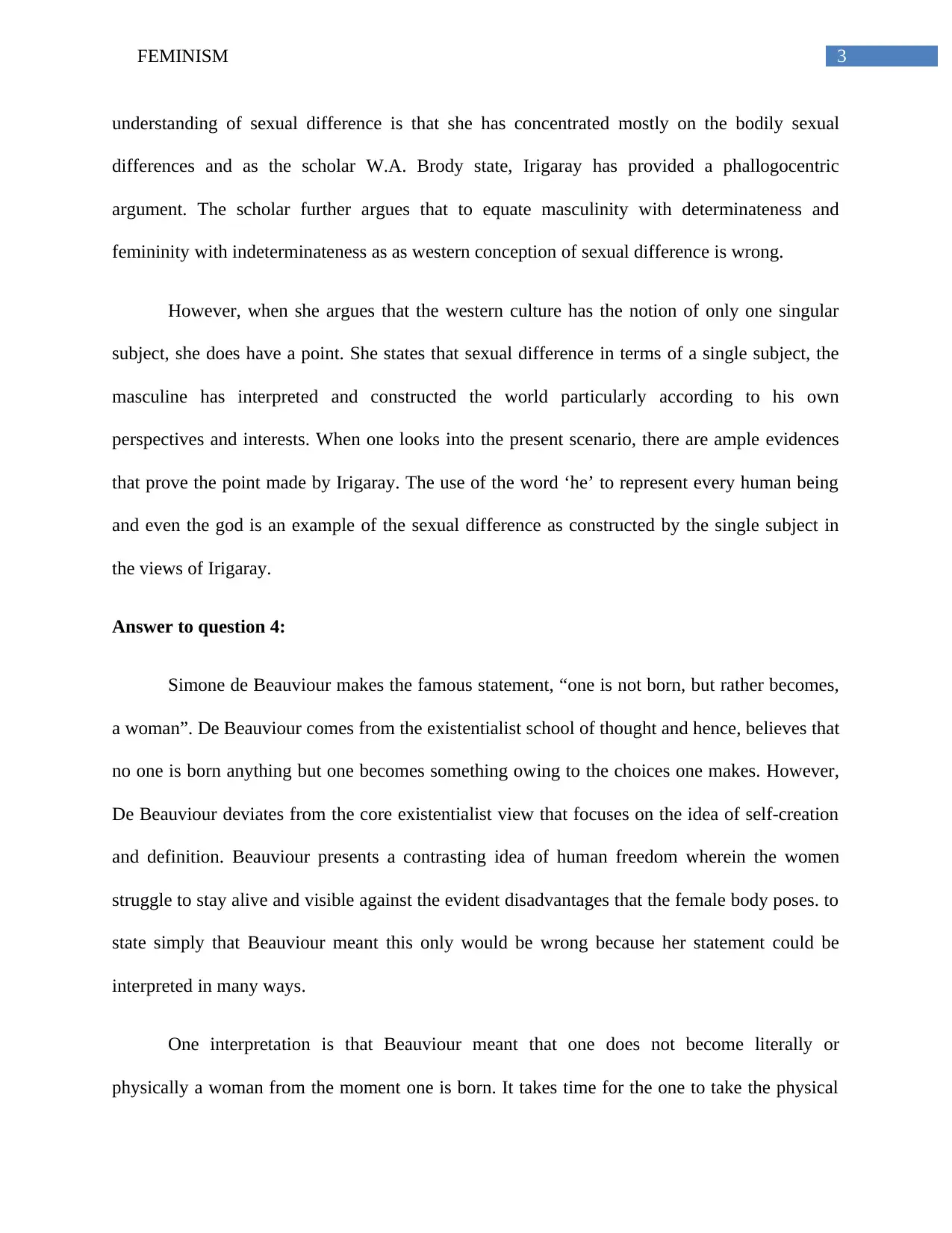
3FEMINISM
understanding of sexual difference is that she has concentrated mostly on the bodily sexual
differences and as the scholar W.A. Brody state, Irigaray has provided a phallogocentric
argument. The scholar further argues that to equate masculinity with determinateness and
femininity with indeterminateness as as western conception of sexual difference is wrong.
However, when she argues that the western culture has the notion of only one singular
subject, she does have a point. She states that sexual difference in terms of a single subject, the
masculine has interpreted and constructed the world particularly according to his own
perspectives and interests. When one looks into the present scenario, there are ample evidences
that prove the point made by Irigaray. The use of the word ‘he’ to represent every human being
and even the god is an example of the sexual difference as constructed by the single subject in
the views of Irigaray.
Answer to question 4:
Simone de Beauviour makes the famous statement, “one is not born, but rather becomes,
a woman”. De Beauviour comes from the existentialist school of thought and hence, believes that
no one is born anything but one becomes something owing to the choices one makes. However,
De Beauviour deviates from the core existentialist view that focuses on the idea of self-creation
and definition. Beauviour presents a contrasting idea of human freedom wherein the women
struggle to stay alive and visible against the evident disadvantages that the female body poses. to
state simply that Beauviour meant this only would be wrong because her statement could be
interpreted in many ways.
One interpretation is that Beauviour meant that one does not become literally or
physically a woman from the moment one is born. It takes time for the one to take the physical
understanding of sexual difference is that she has concentrated mostly on the bodily sexual
differences and as the scholar W.A. Brody state, Irigaray has provided a phallogocentric
argument. The scholar further argues that to equate masculinity with determinateness and
femininity with indeterminateness as as western conception of sexual difference is wrong.
However, when she argues that the western culture has the notion of only one singular
subject, she does have a point. She states that sexual difference in terms of a single subject, the
masculine has interpreted and constructed the world particularly according to his own
perspectives and interests. When one looks into the present scenario, there are ample evidences
that prove the point made by Irigaray. The use of the word ‘he’ to represent every human being
and even the god is an example of the sexual difference as constructed by the single subject in
the views of Irigaray.
Answer to question 4:
Simone de Beauviour makes the famous statement, “one is not born, but rather becomes,
a woman”. De Beauviour comes from the existentialist school of thought and hence, believes that
no one is born anything but one becomes something owing to the choices one makes. However,
De Beauviour deviates from the core existentialist view that focuses on the idea of self-creation
and definition. Beauviour presents a contrasting idea of human freedom wherein the women
struggle to stay alive and visible against the evident disadvantages that the female body poses. to
state simply that Beauviour meant this only would be wrong because her statement could be
interpreted in many ways.
One interpretation is that Beauviour meant that one does not become literally or
physically a woman from the moment one is born. It takes time for the one to take the physical
Paraphrase This Document
Need a fresh take? Get an instant paraphrase of this document with our AI Paraphraser
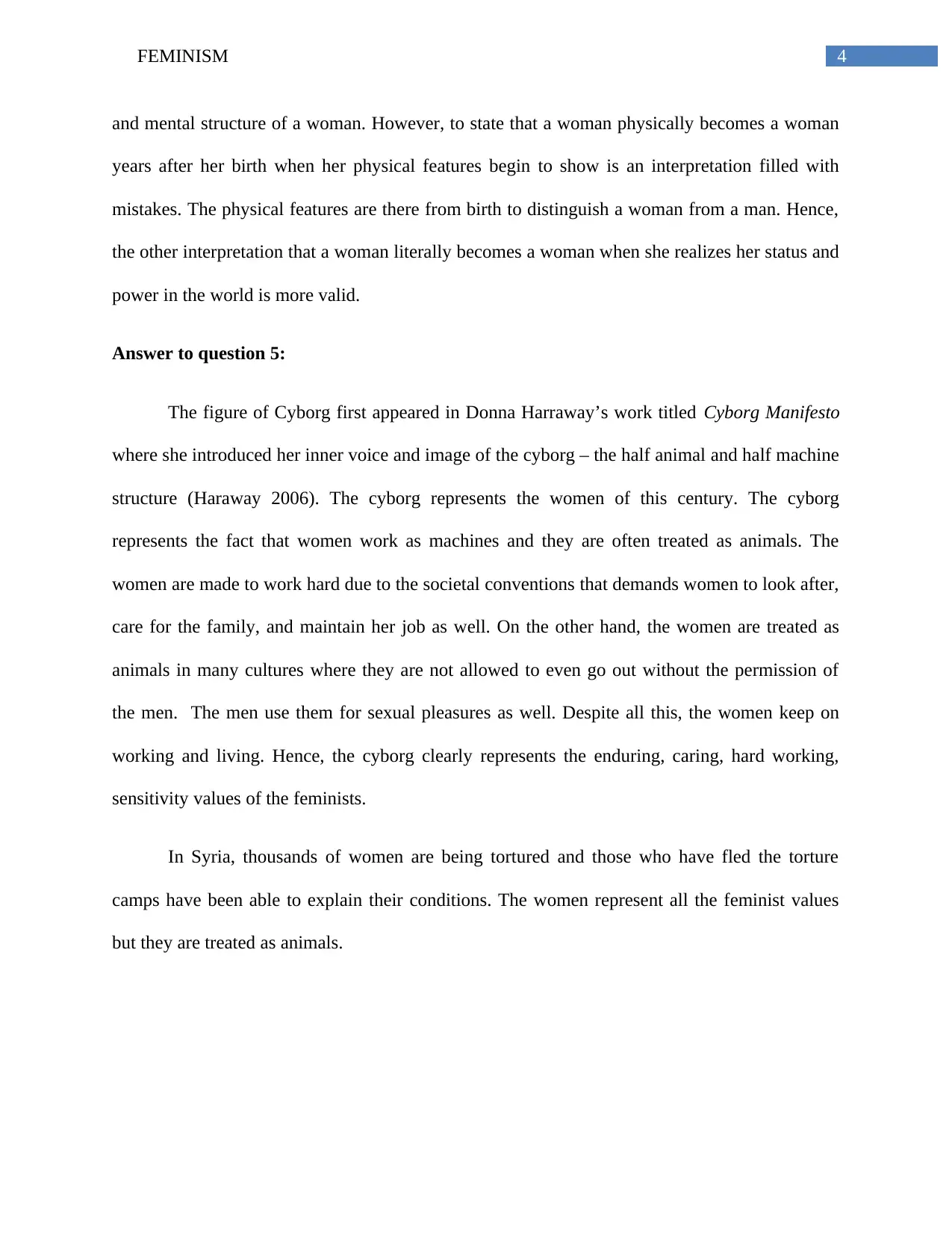
4FEMINISM
and mental structure of a woman. However, to state that a woman physically becomes a woman
years after her birth when her physical features begin to show is an interpretation filled with
mistakes. The physical features are there from birth to distinguish a woman from a man. Hence,
the other interpretation that a woman literally becomes a woman when she realizes her status and
power in the world is more valid.
Answer to question 5:
The figure of Cyborg first appeared in Donna Harraway’s work titled Cyborg Manifesto
where she introduced her inner voice and image of the cyborg – the half animal and half machine
structure (Haraway 2006). The cyborg represents the women of this century. The cyborg
represents the fact that women work as machines and they are often treated as animals. The
women are made to work hard due to the societal conventions that demands women to look after,
care for the family, and maintain her job as well. On the other hand, the women are treated as
animals in many cultures where they are not allowed to even go out without the permission of
the men. The men use them for sexual pleasures as well. Despite all this, the women keep on
working and living. Hence, the cyborg clearly represents the enduring, caring, hard working,
sensitivity values of the feminists.
In Syria, thousands of women are being tortured and those who have fled the torture
camps have been able to explain their conditions. The women represent all the feminist values
but they are treated as animals.
and mental structure of a woman. However, to state that a woman physically becomes a woman
years after her birth when her physical features begin to show is an interpretation filled with
mistakes. The physical features are there from birth to distinguish a woman from a man. Hence,
the other interpretation that a woman literally becomes a woman when she realizes her status and
power in the world is more valid.
Answer to question 5:
The figure of Cyborg first appeared in Donna Harraway’s work titled Cyborg Manifesto
where she introduced her inner voice and image of the cyborg – the half animal and half machine
structure (Haraway 2006). The cyborg represents the women of this century. The cyborg
represents the fact that women work as machines and they are often treated as animals. The
women are made to work hard due to the societal conventions that demands women to look after,
care for the family, and maintain her job as well. On the other hand, the women are treated as
animals in many cultures where they are not allowed to even go out without the permission of
the men. The men use them for sexual pleasures as well. Despite all this, the women keep on
working and living. Hence, the cyborg clearly represents the enduring, caring, hard working,
sensitivity values of the feminists.
In Syria, thousands of women are being tortured and those who have fled the torture
camps have been able to explain their conditions. The women represent all the feminist values
but they are treated as animals.
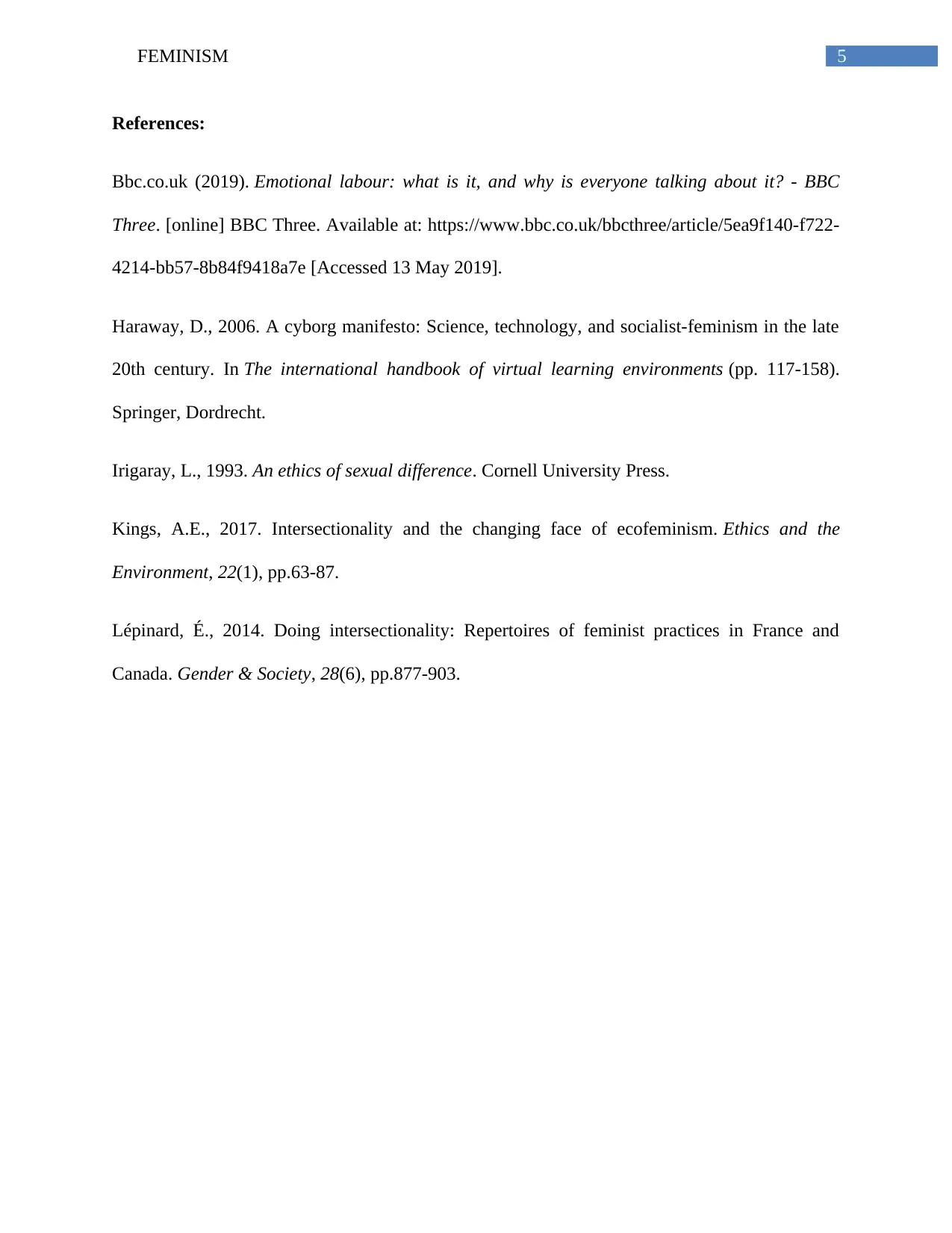
5FEMINISM
References:
Bbc.co.uk (2019). Emotional labour: what is it, and why is everyone talking about it? - BBC
Three. [online] BBC Three. Available at: https://www.bbc.co.uk/bbcthree/article/5ea9f140-f722-
4214-bb57-8b84f9418a7e [Accessed 13 May 2019].
Haraway, D., 2006. A cyborg manifesto: Science, technology, and socialist-feminism in the late
20th century. In The international handbook of virtual learning environments (pp. 117-158).
Springer, Dordrecht.
Irigaray, L., 1993. An ethics of sexual difference. Cornell University Press.
Kings, A.E., 2017. Intersectionality and the changing face of ecofeminism. Ethics and the
Environment, 22(1), pp.63-87.
Lépinard, É., 2014. Doing intersectionality: Repertoires of feminist practices in France and
Canada. Gender & Society, 28(6), pp.877-903.
References:
Bbc.co.uk (2019). Emotional labour: what is it, and why is everyone talking about it? - BBC
Three. [online] BBC Three. Available at: https://www.bbc.co.uk/bbcthree/article/5ea9f140-f722-
4214-bb57-8b84f9418a7e [Accessed 13 May 2019].
Haraway, D., 2006. A cyborg manifesto: Science, technology, and socialist-feminism in the late
20th century. In The international handbook of virtual learning environments (pp. 117-158).
Springer, Dordrecht.
Irigaray, L., 1993. An ethics of sexual difference. Cornell University Press.
Kings, A.E., 2017. Intersectionality and the changing face of ecofeminism. Ethics and the
Environment, 22(1), pp.63-87.
Lépinard, É., 2014. Doing intersectionality: Repertoires of feminist practices in France and
Canada. Gender & Society, 28(6), pp.877-903.
⊘ This is a preview!⊘
Do you want full access?
Subscribe today to unlock all pages.

Trusted by 1+ million students worldwide
1 out of 6
Your All-in-One AI-Powered Toolkit for Academic Success.
+13062052269
info@desklib.com
Available 24*7 on WhatsApp / Email
![[object Object]](/_next/static/media/star-bottom.7253800d.svg)
Unlock your academic potential
Copyright © 2020–2025 A2Z Services. All Rights Reserved. Developed and managed by ZUCOL.
